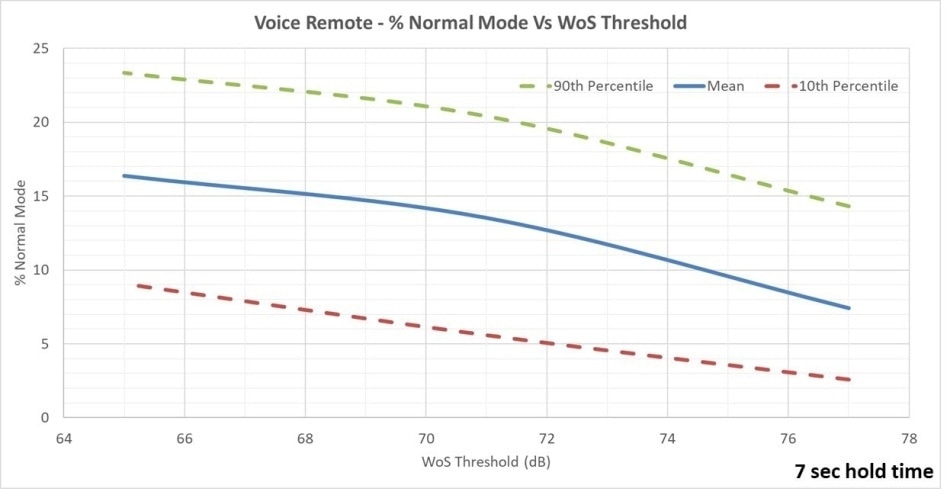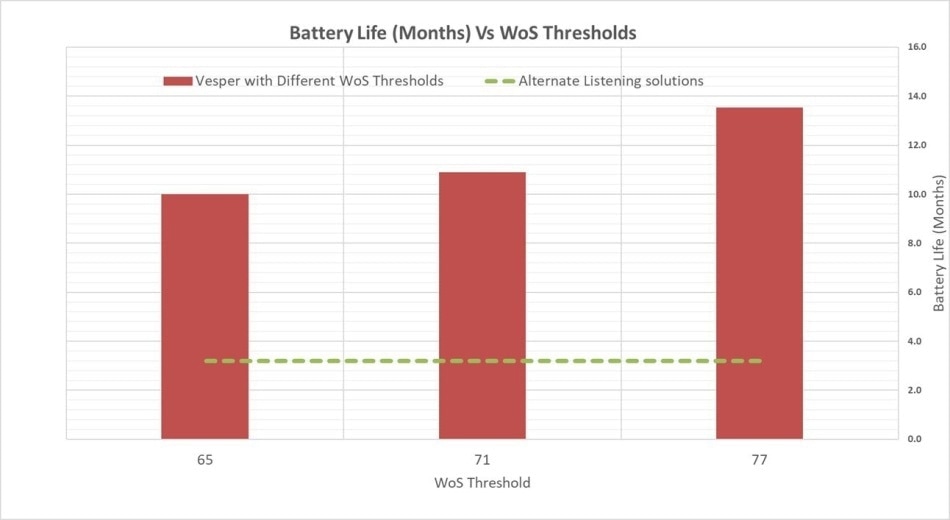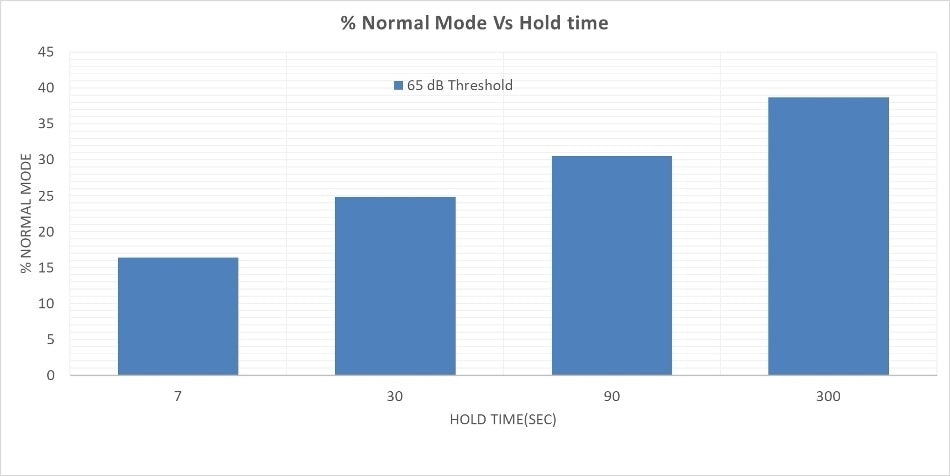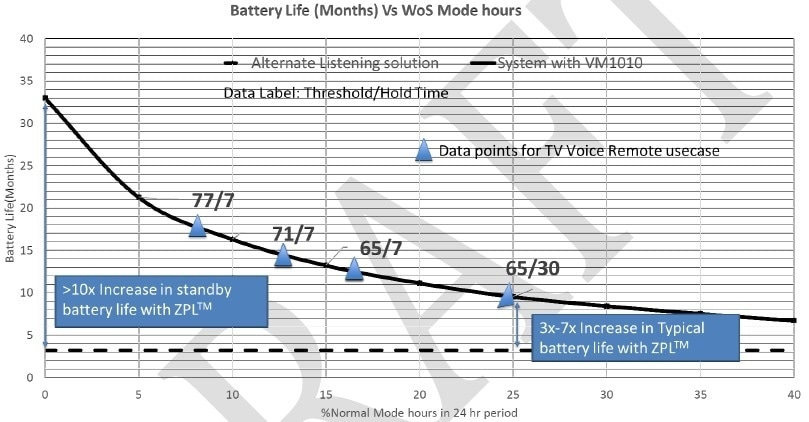Vesper has built data loggers for the VM1010 microphone for different noise thresholds (65 dB, 71 dB and 77 dB) with the aim of studying the frequency of wake commands in a living room environment. The data loggers were then given to Vesper’s employees for the recording of data in their living room for a 24-hour time period.
In the majority of living room use cases for a voice-activated hands-free remote the user tends to be 1-2 meters away from the microphone. In addition, the remote itself tends to be placed a further 2 meters away from the television. For this reason, the dataloggers were sat on a coffee table next to the remote. The experiment was ran once on a weekday and once more over the weekend to account for differences in household schedules at these different times.
The data logger recorded all WoS triggers and the hold times, which were between 7 seconds and 5 minutes, and these were then analyzed. This article will explore this analysis, using 700 hours of data from 24 different households, in terms of the effect of two metrics, hold time and noise threshold, on battery lifetime. The households used in the study showed a range of occupants (from 1-5) and also included environmental noise from pets, children and other external factors.
Selecting the Acoustic Threshold
An average household in the United States uses the television for four hours a day on average. Given this high level of usage it would be easy to believe that the remote’s noise threshold should be set to a higher SPL value to avoid being woken by the TV when it is not actually required. However, whilst the system will be falsely triggered by the TV a few times, in general the system’s peak detect mechanism reduces the number of false triggers by the TV.
The average audio volume of televisions in conjunction with the distance between the television and the remote automatically reduces the peak sound pressure level experienced by the remote’s WoS microphone. Vesper’s collected data, which includes all wakeups from both background noise and the television (Figure 9), shows that for any set noise threshold normal mode time is only ran between 15-25% of the day.
In a quiet living room with no television playing the ambient sound in the living room is below the VM1010’s 65 dB minimum threshold. This means that the microphone would be operating in WoS mode and listening only for sound activity for most of the time in a 24 hour time period. The typical speech of a remote user lies around 70 dBSPL meaning they can easily turn on the remote. Setting the noise threshold above 65 dB could mean that the user must shout at the remote to activate it, which would negatively impact the user experience.
Vesper’s data demonstrates that energy savings from reducing normal time mode are only marginally better when the noise threshold is set at 71 dB rather than 65 dB. For this reason, the noise threshold for a WoS remote is recommended as this is the best balance between increased battery life and improved user experience.

Figure 9: % Normal mode Vs. WoS Threshold.

Figure 10: Battery life (months) Vs. WoS Threshold.
Selecting the Hold Time
The hold time is the time period between the VM1010 being woken up (and being in ‘normal’ mode) before it returns to WoS mode. This time is programmed in at the system level, meaning the DSP can monitor any background activity and put the device back into WoS mode when needed.
Figure 11 illustrates the volume of time that the microphone spends in normal mode over a range of hold times (between 7 seconds and 5 minutes) when the microphone has a noise threshold set at 65 dB. Using a 5 minute hold time means the system spends more than double the time in normal mode compared to a 7 second hold time.

Figure 11: % Normal mode Vs. Hold time.
Setting up the remote so that the hold time is shorter results in an improved battery lifetime as the system spends more time in energy-saving WoS mode. In addition, a shorter hold time is also beneficial in household environments where background speech can result in false commands. In these instances, setting the system with a longer hold time could result in many false wakeups.
Conversely, the microphone should have a long enough hold time to allow it to hear full voice commands, and not to switch off mid-command. For a handsfree remote for a typical TV application, where voice commands are relatively short (e.g. ‘pause’, ‘play’, ‘Open House of Cards’) a hold time that ranges between 7 seconds and 30 seconds is usually sufficient.
The graph shown in Figure 12 illustrates the extension of battery lifetime for a handsfree WoS remote using the VM1010 recommended settings – as demonstrated, 10 times more battery life is gained using ZPL™. For a standard battery setting the microphone with a 7 second hold time and a noise threshold of 65 dB provides 3 times more battery life, and this can be extended to up to 7 times more if a higher noise threshold is used.

Figure 12: Far-field Voice Remote: Battery Life (months) vs. % Normal mode.
Add-on Benefits with Vesper’s Piezo Microphones
Piezoelectric microphones from Vesper Technologies can also provide more benefits for voice operated remotes. The Piezoelectric MEMS technology used in the systems has an extremely short wake up time of 200 μs – this is 1000 times faster than capacitive MEMS technology which means a higher level of keyword detection accuracy can be achieved.
In addition, Piezoelectric systems are intrinsically resistant to environmental contamination from dust, water and household mess such as oil (and popcorn butter!) which means the system can perform over long time periods in household environments.
Conclusion
In the future, where voice operated technologies will be ubiquitous, Vesper’s WoS microphones can help increase both battery lifetime and user experience for voice operated TV control.
The combination of ultra-low power audio SoCs and ZPL™ allow the design of compact, far-field, voice-operated remotes which need only a coin battery to operate. These systems will be more convenient than current ‘push to talk’ systems whilst also having comparable battery lifetimes. These benefits can all be added to current technologies due to ZPL™ requiring only small design changes to be integrated into existing systems.
Now that Vesper has broken down the barriers presented by voice system power consumption in remote controls it is expected that this technology will be used in the next generation of Smart TVs.

 Download the Full White Paper Here
Download the Full White Paper Here

This information has been sourced, reviewed and adapted from materials provided by Vesper Technologies, Inc.
For more information on this source, please visit Vesper Technologies, Inc.